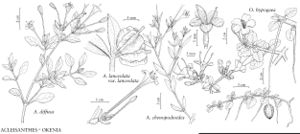Okenia hypogaea
Linnaea 5: 92. 1830.
Stems 0.2–2 m. Leaves: small leaf of pair often not equaling petiole of larger leaf; petiole 8–45 mm; blade ovate, ovate-deltate, or elliptic-ovate, 9–50 × 3–45 mm, base slightly to strongly oblique, truncate to cordate, margins sinuate and undulate, apex usually rounded, sometimes obtuse or acute, surfaces often red-punctate. Inflorescences: peduncle 1–9 mm at anthesis, rapidly elongating and curving downward as perianth wilts, ultimately 10–30 cm. Perianth magenta [rarely yellow], 10–30[–50] × 9–30[–45] mm. Fruits brownish or whitish, 9–13 × 6–9 mm.
Phenology: Flowering early spring–late fall [year-round].
Habitat: Sandy areas along coast [inland]
Elevation: 0[-1800] m
Distribution

Fla., Mexico, Central America (Nicaragua).
Discussion
A. L. Bogle (1974) indicated that the flowers of Okenia hypogaea may be cleistogamous. Information provided on a specimen label suggests that flowers with a conspicuous perianth are staminate and that cleistogamous flowers are rare. The reproductive biology is in need of study. Herbarium specimens very rarely contain fruits. Peduncles may be mistaken for adventitious roots by collectors, the fruit very easily torn from the peduncle as the plant is taken. The descending peduncle resembles a root to the point that a conic cap of cells, resembling a root cap, develops over the tip of the perianth base that is to become part of the fruit (A. L. Bogle 1974).
Selected References
None.
